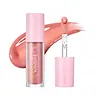What's inside
What's inside
 Key Ingredients
Key Ingredients

 Benefits
Benefits

 Concerns
Concerns

 Ingredients Side-by-side
Ingredients Side-by-side

Hydrogenated Polyisobutene
EmollientDiisostearyl Malate
EmollientCaprylic/Capric Triglyceride
MaskingSilica Dimethyl Silylate
EmollientButyrospermum Parkii Butter
Skin ConditioningSorbitan Isostearate
EmulsifyingSilica
AbrasiveSynthetic Wax
Abrasive1,2-Hexanediol
Skin ConditioningDisteardimonium Hectorite
StabilisingCaprylyl Glycol
EmollientCI 77891
Cosmetic ColorantCalcium Aluminum Borosilicate
Tocopheryl Acetate
AntioxidantCI 77491
Cosmetic ColorantParfum
MaskingCI 77499
Cosmetic ColorantCI 15850
Cosmetic ColorantTin Oxide
AbrasiveSimmondsia Chinensis Seed Oil
EmollientMangifera Indica Seed Oil
EmollientOlea Europaea Fruit Oil
MaskingCI 19140
Cosmetic ColorantCI 15985
Cosmetic ColorantHydrogenated Polyisobutene, Diisostearyl Malate, Caprylic/Capric Triglyceride, Silica Dimethyl Silylate, Butyrospermum Parkii Butter, Sorbitan Isostearate, Silica, Synthetic Wax, 1,2-Hexanediol, Disteardimonium Hectorite, Caprylyl Glycol, CI 77891, Calcium Aluminum Borosilicate, Tocopheryl Acetate, CI 77491, Parfum, CI 77499, CI 15850, Tin Oxide, Simmondsia Chinensis Seed Oil, Mangifera Indica Seed Oil, Olea Europaea Fruit Oil, CI 19140, CI 15985
Water
Skin ConditioningDiphenyl Dimethicone
EmollientDiisostearyl Malate
EmollientBis-Diglyceryl Polyacyladipate-2
EmollientHydrogenated Polyisobutene
EmollientBis-Behenyl/Isostearyl/Phytosteryl Dimer Dilinoleyl Dimer Dilinoleate
EmollientDiglycerin
HumectantCetyl PEG/PPG-10/1 Dimethicone
EmulsifyingDipropylene Glycol
HumectantHydrogenated Poly(C6-14 Olefin)
EmollientPolysorbate 60
EmulsifyingSorbitan Isostearate
EmulsifyingDiisostearoyl Polyglyceryl-3 Dimer Dilinoleate
EmollientPentylene Glycol
Skin ConditioningHydroxyethyl Acrylate/Sodium Acryloyldimethyl Taurate Copolymer
Emulsion StabilisingCaprylic/Capric Triglyceride
MaskingSqualane
EmollientCeteareth-20
CleansingEthylene/Propylene Copolymer
AbrasivePhenoxyethanol
PreservativeGlycerin
HumectantCI 77891
Cosmetic ColorantPolyglycerin-3
HumectantCI 15985
Cosmetic ColorantParfum
MaskingEthylhexylglycerin
Skin ConditioningCI 17200
Cosmetic ColorantCI 45410
Cosmetic ColorantCI 42090
Cosmetic ColorantHamamelis Virginiana Leaf Extract
Skin ConditioningLilium Tigrinum Extract
Skin ConditioningButylene Glycol
HumectantWater, Diphenyl Dimethicone, Diisostearyl Malate, Bis-Diglyceryl Polyacyladipate-2, Hydrogenated Polyisobutene, Bis-Behenyl/Isostearyl/Phytosteryl Dimer Dilinoleyl Dimer Dilinoleate, Diglycerin, Cetyl PEG/PPG-10/1 Dimethicone, Dipropylene Glycol, Hydrogenated Poly(C6-14 Olefin), Polysorbate 60, Sorbitan Isostearate, Diisostearoyl Polyglyceryl-3 Dimer Dilinoleate, Pentylene Glycol, Hydroxyethyl Acrylate/Sodium Acryloyldimethyl Taurate Copolymer, Caprylic/Capric Triglyceride, Squalane, Ceteareth-20, Ethylene/Propylene Copolymer, Phenoxyethanol, Glycerin, CI 77891, Polyglycerin-3, CI 15985, Parfum, Ethylhexylglycerin, CI 17200, CI 45410, CI 42090, Hamamelis Virginiana Leaf Extract, Lilium Tigrinum Extract, Butylene Glycol
 Reviews
Reviews

Ingredients Explained
These ingredients are found in both products.
Ingredients higher up in an ingredient list are typically present in a larger amount.
This ingredient is an emollient, solvent, and texture enhancer. It is considered a skin-softener by helping the skin prevent moisture loss.
It helps thicken a product's formula and makes it easier to spread by dissolving clumping compounds.
Caprylic Triglyceride is made by combining glycerin with coconut oil, forming a clear liquid.
While there is an assumption Caprylic Triglyceride can clog pores due to it being derived from coconut oil, there is no research supporting this.
Learn more about Caprylic/Capric TriglycerideCi 15985 is a dye made from petroleum. It is synthetically created and approved by the FDA for use in foods and cosmetics.
The color of this dye is orange/yellow.
This ingredient can be found in makeup, sun care, and skincare.
Learn more about CI 15985Ci 77891 is a white pigment from Titanium dioxide. It is naturally found in minerals such as rutile and ilmenite.
It's main function is to add a white color to cosmetics. It can also be mixed with other colors to create different shades.
Ci 77891 is commonly found in sunscreens due to its ability to block UV rays.
Learn more about CI 77891Diisostearyl Malate is an emollient and most often used in lip products. It comes from isostearyl alcohol, a fatty acid, and malic acid, an AHA.
As an emollient, Diisostearyl Malate helps create a thin film on your skin to trap moisture in. This helps keep your skin soft and smooth.
Hydrogenated Polyisobutene is a synthetic polymer. Polymers are compounds with high molecular weight. Hydrogenated Polyisobutene is an emollient and texture enhancer.
In one study, Hydrogenated Polyisobutene showed better skin hydration levels than Caprylic/Capric Triglyceride. As an emollient, it helps keep your skin soft and hydrated by trapping moisture in.
Hydrogenated Polyisobutene is often used as a mineral oil replacement.
Learn more about Hydrogenated PolyisobuteneParfum is a catch-all term for an ingredient or more that is used to give a scent to products.
Also called "fragrance", this ingredient can be a blend of hundreds of chemicals or plant oils. This means every product with "fragrance" or "parfum" in the ingredients list is a different mixture.
For instance, Habanolide is a proprietary trade name for a specific aroma chemical. When used as a fragrance ingredient in cosmetics, most aroma chemicals fall under the broad labeling category of “FRAGRANCE” or “PARFUM” according to EU and US regulations.
The term 'parfum' or 'fragrance' is not regulated in many countries. In many cases, it is up to the brand to define this term.
For instance, many brands choose to label themselves as "fragrance-free" because they are not using synthetic fragrances. However, their products may still contain ingredients such as essential oils that are considered a fragrance by INCI standards.
One example is Calendula flower extract. Calendula is an essential oil that still imparts a scent or 'fragrance'.
Depending on the blend, the ingredients in the mixture can cause allergies and sensitivities on the skin. Some ingredients that are known EU allergens include linalool and citronellol.
Parfum can also be used to mask or cover an unpleasant scent.
The bottom line is: not all fragrances/parfum/ingredients are created equally. If you are worried about fragrances, we recommend taking a closer look at an ingredient. And of course, we always recommend speaking with a professional.
Learn more about ParfumSorbitan Isostearate is an emulsifer and cleaning agent. It is created from isostearic acid and sorbitol.
As an emulsifier, Sorbitan Isostearate prevents oils and water from separating.
Due to its isostearic acid base, it may not be safe for Malassezia or fungal acne.
Learn more about Sorbitan Isostearate